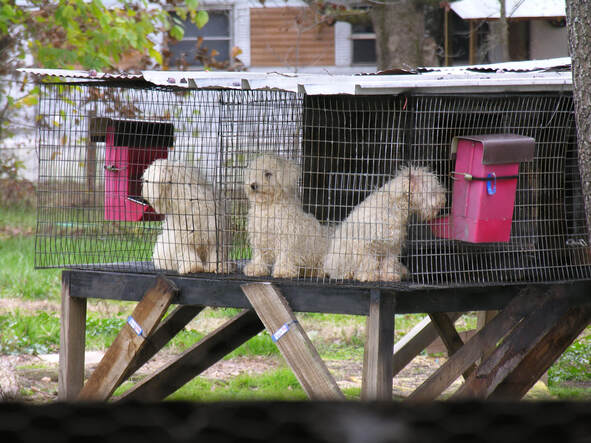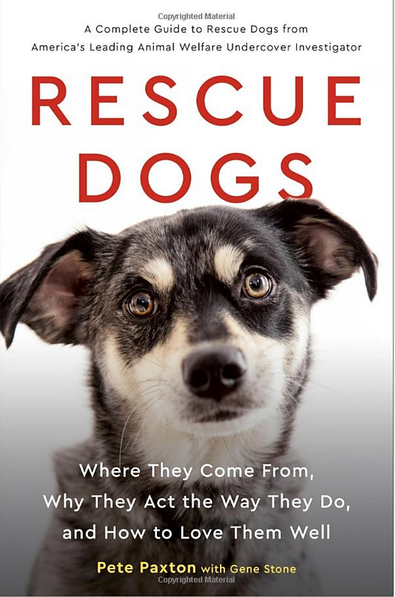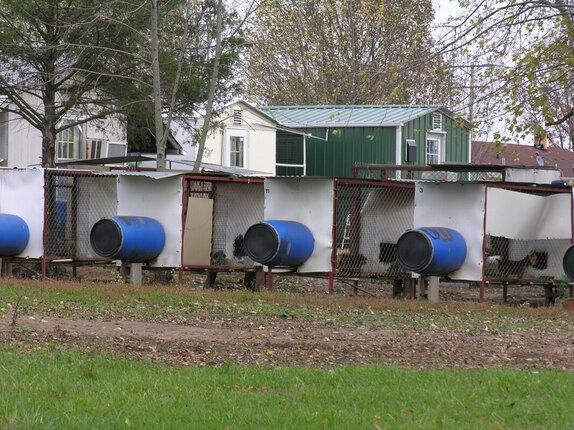|
I’m sure I’ve said it before, but it bears repeating. I meet some of the most amazing people thanks to my animal welfare advocacy. Most are just normal people like you and me who are on a mission related to animals, using their superpowers for the good of us all. I’ve only met a handful of these folks in person, but thanks to the inter-connectivity of our world provided by video conferencing and email, I still feel as though I know them. And I am proud to say I do. I first learned about “Pete Paxton” last fall when I learned about his book (co-written with Gene Stone) called Rescue Dogs: Where They Come From, Why They Act the Way They Do, and How to Love Them Well. Pete’s name is in quotes because I honestly have no idea what his real name is, You see, he’s an undercover investigator who has done incredible work for the Companion Animal Protection Society. (I encourage you to visit the CAPS website to help further your education). Pete has been to over 700 puppy mills, hundreds of pet stores, and has worked undercover at some of the biggest mills in the United States. Rescue Dogs is aimed at exposing mills and explaining how the public can help fight them by adopting dogs. The book also explains finding a good shelter or foster group, dog training tips, how to rescue stray/abuse dogs, and busts myths about shelter dogs being “broken” in some way. I have long railed against the commercial dog breeding industry and have long supported rescue and advocacy groups which help dogs saved from mills and which educate the public toward bringing an end to the industry. I’ve worked on local laws which keep national pet supply chains from setting up shop in communities and importing sick dogs from puppy mills which can, in turn, make people sick. I’ve fought state legislation which would allow pet supply chains to grow roots in my state and further erode the humane treatment of dogs in a culture lost in time compared to the values regarding dogs in the rest of the country. When I heard about Pete’s book and his undercover work in the mills themselves, I just had to read it The first part of Rescue Dogs was a hard read for me, but not in a bad way. As you would imagine, there is something quite criminal (and, I would argue, nefarious) about the way many people in our society treat dogs for their financial gain. It is heartbreaking, infuriating and mind-boggling. And I say that as a person who has never walked a path remotely close to the one walked by Pete. I cannot possibly imagine the mental and emotional toll taken on people who take on fake identities and put themselves in the bowels of hell in order to take down the very people whose behavior we find abhorrent. I am confident that we cannot possibly understand what Pete and others like him have endured for the sake of dogs and for the sake of all of us. Could you pretend to be someone you are not and work in a place where dogs are abused, neglected or killed on a regular basis all for the sake of money to collect evidence? I know I could not. Which is why I consider Pete one of my animal superheroes. The second part of the book was incredibly informative. I think that most people in the shelter and rescue world assume the public knows all about rescue dogs, where they come from, how wonderful they are and why adopting a rescue dog is such a compelling choice. Many people just do not know, even if we think they should. Thanks to Pete’s book, now they can. He goes into great depth about where many of these dogs come from, how they think and how to make them members of our families – as opposed to buying dogs from the million dollar industry which has no regard for their well-being, viewing them not as sentient creatures but as things. Pete was kind enough to help me introduce you to information which goes beyond the book through the Q&A that follows. I think it’s helpful for me to say a few things about the book, but I want you to learn something information not found in the book to entice you to read it. You can find Rescue Dogs on all major book selling platforms and at your local bookstore. I hope you enjoy our exchange. You repeatedly use the phrase “puppy mill” in the book. I also use this phrase as a reflection of volume of dogs produced as well as the conditions in which they live. What does that phrase mean to you? To me, “puppy mill” refers to any facility or person who raises dogs for profit. I realize that puts individuals who sell a litter of puppies every two years to neighbors into that category. However, I use the term “puppy mill” to refer to anyone that is part of a system that results in dogs being killed in shelters and exploited for human gain. Whether a facility keeps dogs in the house or a kennel, has two dogs or a hundred, or is licensed or not, they are contributing to that system. Most people who love animals would have an incredibly difficult time investigating undercover like you did while staying in character. Your work must have been difficult beyond description. How were you able to stay so focused to see the investigations through to collect enough evidence? I appreciate the kind words. I’d like to say I’m just that tough, but I think part of it relies on my personality. I enjoy taking risks and improvising puts me in my comfort zone. Undercover work does involve suffering moral injury, but it also involves Adrenalin. Whether it’s a lot or a little, the Adrenalin is often there, and if you enjoy taking risks than it changes some situations that would normally repulse you into ones you want to dive into. Essentially, it’s the work itself that keeps me motivated, which I believe is true for any professional who enjoys their job. In specific cases, though, it is knowing that if I quit, I’m letting victims down. In most undercover investigations, there’s no second chance to get the evidence. If you lose patience or will, it means everything you’ve seen animals suffer for will be for nothing. When I started doing investigations and would sometimes complain about stress to friends and family members, they would tell me I should walk away from cases and take care of myself. I would tell them instead to remind me that anything I’m going through is nothing compared to what the victims I’m documenting are going through. Friends who used to tell me, “Take care of yourself,” now tell me, “Cowboy up and stop whining.” It’s quite motivating. Do you still do undercover work to this day? I would imagine that someone can only do that kind of work for a certain amount of time before they need to take a break. I still work undercover, and much of it still for the Companion Animal Protection Society, which I mention in Rescue Dogs. I take breaks when needed, sometimes for weeks at a time depending on how many reports from past work and research for future work I have to keep me busy. Enough time behind a computer and I’m dying to go back in the field. Stopping to write Rescue Dogs was a particularly long and unusual break for me. It was a difficult process going through so many old case notes and videos to verify details and write about things from years ago in a narrative manner. My field notes allow me to remove emotions from the context of evidence. Rescue Dogs had me write about that evidence in an emotional manner, in which my thoughts and feelings were as much the focus as the victims concerning them. At times it was cathartic, and at times it made it impossible to sleep. In the end, I’m very grateful I did it and that authors Gene Stone and Nick Bromley worked the entire process with me. You write about dogs you met during your investigative work you wanted to help but could not because it would have blown your cover. Are there any specific dogs who haunt you or do you have any regrets? This is where things will get dark. There are so many dogs that haunt me that the vast majority of them are not even mentioned in Rescue Dogs because there was no need to drag readers through the memories of so much cruelty, when one story alone could make the point. It was painfully difficult to select which dogs would be used in stories. In every investigation I’ve done, whether of a puppy mill, factory farm, slaughterhouse, or commercial fishing boat, there are victims whose stories are never told publicly. Often, it’s that there’s so many victims that it’s not possible to concisely explain what happened to them all in a video or interview. Other times, it’s that some victims are part of a crime that is irrelevant to other evidence the press or a client wants to focus on. If you ever see a video about an animal cruelty case, you should know that you’re not seeing half of what happened. You’re only seeing enough to try to keep your attention so you can then read about what you can do to help without shutting the video off. There are so many dogs I want to mention whose individual stories are not told in Rescue Dogs that I feel like I’m suffocating under them. However, the reality is that I’ve tried to tell those stories to people. I’ve tried writing about them, explaining them in person, and discussing them in interviews. It’s simply too much for people to handle. It drags people through emotional turmoil and isn’t necessary to make them understand a subject. The problem I have is that while undercover, I very rarely get an opportunity to help animals. I have seen many dogs suffer and die without saving them. For so many to be lost in a bigger picture, without their stories told, I feel like I’m betraying them and not giving them the final dignity they deserve. I have been in so many morally ambiguous situations that shame and pride have often been synonymous for me. Choosing which victims will have their stories told is another one of those situations, but I believe we chose well in Rescue Dogs. I imagine you have testified numerous times regarding your investigations. Do you feel the legal process works to hold breeders accountable or is the system (and laws) not in keeping with public values? You may be surprised to learn I’ve rarely had to testify in court. Most of the time, when a defendant has so much evidence piled against them that they are dead to rights, they plead out. That said, I’ve testified in front a jury, without a jury, in front a grand jury, and dealt with both good and bad law enforcement at the county, city, state, and federal level. Here’s the short version: The system doesn’t work for animals. Here’s the longer version: As written, most cruelty statutes make causing unnecessary suffering a violation. You’d think that would make it pretty easy to bust breeders who don’t treat dogs’ wounds, leave them to the elements, or let their teeth rot in their heads. The problem is that culture supersedes enforcement. The vast majority of breeding dogs are in commercial kennels, and the vast majority of those kennels are in rural areas where commercially bred dogs are treated as livestock. In fact, dogs are often seen as an alternative livestock that can be more profitable than other animals. Compared to hogs, for example, puppies are more profitable by the head and you can keep a larger number of breeding stock in a smaller amount of space. Most states have exemptions to cruelty statutes if an act that would normally be considered illegal (such as mutilating an animal without anesthesia) is a routine operation on a farm. The difference between legal cruelty and illegal cruelty becomes so difficult to discern that cruelty laws are rarely ever enforced on farms. Since puppy mills are seen by farmers as the same as hog farms or dairies, local law enforcement typically ignores cruelty complaints about puppy mills just as they do hog farms and dairies. Furthermore, many commercial kennels are licensed by the US Department of Agriculture. The same agency that inspects slaughterhouses inspect dog breeding kennels. That agency has a dual motive of enforcing regulations while promoting the industries they license. The more enforcement actions they take, the more they are cracking down on an industry they want to promote. Therefore, the USDA notoriously lets violations go. I’ve seen USDA inspectors ignore dogs dying in cages and even warn people ahead of time they will be inspected. Many inspectors prefer to be friendly with breeders instead of confrontational with them. To assist inspectors, the USDA has a policy called “teachable moments,” allowing inspectors to tell the breeders to fix violations on their own instead of them even been written in a report. When desensitization to animal cruelty, law enforcement corruption, and government corruption come together, I call it a “culture of cruelty.” Commercial dog kennels often exist in this culture. I have been unapologetic in my criticism of rescue groups that buy dogs at auction and call it rescue. What do you think about rescuers and rescue groups that buy dogs at auctions and make it sound like they have done something good (while showing no regard for the dogs who will take the place of the dogs they paid for)? I applaud your criticism. Activists buying dogs at auctions provide funding for puppy millers to buy more dogs and keep their operations going. Many puppy millers have rescue groups take their spent breeding dogs, but breeders will have no incentive to do so if they can profit from selling the dogs instead. What is the single most important thing you think people need to know about commercial dog breeding operations in order to deter them from buying dogs in pet stores? I have two single most important things to mention. For commercial dog breeding kennels, you should know that most of them are worse than you’d imagine. For pet stores, you should know that most lie to you about their breeders in ways that are bold and ridiculous, but clever. Even commercial dog kennels that are clean and have few dogs frequently have problems such as severe dental issues for dogs. Dogs also frequently suffer from anxiety being kept in cages and pens. There is no part of the Animal Welfare Act (USDA’s standards for licensed puppy mills) that has anything to do with dogs’ psychological well-being. It covers cage size, cleaning regulations, and even regulations for lighting, but even puppy mills that follow the standards have no rules make sure their dogs are actually happy. Pet stores frequently show videos of breeders with dogs and puppies running in exercise yards, and point to a part of the Animal Welfare Act that says breeders have to regularly exercise their dogs. The closest I’ve ever seen a breeder come to actually following the exercise regulation is to occasionally put dogs into pens larger than the dogs’ cages or runs. Pet stores show videos of dogs running through lush green yards, which if dogs were to actually be in every day, would be worn down to dirt. Pet stores will lie and say their breeders keep dogs in their homes, have only a few dogs instead of hundreds, play with the dogs all the time, and treat the dogs like family. Most customers don’t know how to disprove photos and videos shown to them as though they are fact, or to contradict someone who says they personally visit breeders selling to a store. The simple reality that I’ve seen, as evidenced on the website for the Companion Animal Protection Society (caps-web.org), is that pet stores lie. A writer once told me that there will always be a need for large scale commercial dog breeding to meet demand and that if we want breeding communities like the Amish to do a better job caring for dogs, we should be prepared to put money toward their operations to raise standards. I could not disagree more. My position is that if they cannot properly care for dogs, they should raise another “cash crop” instead. What do you think? Saying there will always be a need for commercial dog breeders because of customer demand is like saying there would always be a need for cigarettes because customers demanded them. The cigarette industry is thankfully dying, because it exploited people for profit. The puppy mill industry is dying, because it exploits dogs and lies to people for profit. If we want dogs to be treated better, we shouldn’t subsidize an abusive industry. We should abolish it. I agree that breeders can transition from raising dogs to another business. Ingredients for plant-based foods are diversifying, and I would prefer tax subsidy shift from supporting animal agriculture to supporting farmers whose operations are better for the environment and free from animal cruelty. Much of your book is devoted to helping people learn about rescue dogs so they will be informed and will adopt. What do you think people misunderstand the most about these dogs in need of homes? People often think that if they get a rescue dog, they won’t know how the dog will behave. There’s more foster-based rescues and shelters that take time to train dogs now than ever before. Shelter workers and volunteers spend time with dogs to learn their personalities, likes, dislikes, and teach them how to navigate the normal routines of living in a home if they didn’t already know it. Raising a puppy, you can’t guarantee your training will mold the puppy’s personality into who you want. You simply don’t know who you’re getting when you buy a puppy from a breeder, but you are much more likely to know who you’re getting if you adopt a dog from a shelter. People also often think that dogs are dumped at shelters because something is wrong with them and that they all have separation anxiety. That’s simply not true. Most of the time, dogs are given to shelters by people who can’t afford vet bills, won’t take the time to properly train them, are moving and can’t take animals with them, or who found stray animals they can’t keep. There’s nothing wrong with dogs at shelters. In fact, overcoming adversity have can make them better at dealing with change. I believe a time will come when our tax-funded shelters no longer destroy healthy and treatable pets because the public will no longer tolerate the old catch and kill model of sheltering. Do you think this is possible for our future? I think it is possible. The fact that the term “rescue” refers to an adopted pet, and not just an animal taken from an abusive situation or as a stray, is part of a cultural shift that the publicly increasingly recognizes the need to adopt animals instead of purchase from breeders. There is a stigma beginning to be attached to people who buy purebred and designer breed puppies, and a mark of respect for people who adopt. Momentum is building for pet stores to be shut down in the U.S. Welfare legislation, too strict for the worst puppy mills to stay in business, is gaining footholds. Municipal shelters are increasingly working with local rescues to decrease euthanasia rates. The fight against puppy mills is multi-pronged, and we’re seeing every effort have impacts in the entire process. When pet stores ban selling animals from breeders in a major city on the coast, puppy mills in the Midwest start to go out of business when they lose their main market. When false rescues are shut down, the same thing occurs. All of this makes me optimistic. Your book was published in October of 2019. What has the feedback been like? The main responses are that readers have learned a lot about the puppy mill industry in ways they haven’t before, particularly in understanding how puppy mills operate in ways that are hidden from us. Other readers have noted being happy with the amount of information on how to rescue dogs, with different people noting different sections of the book as most useful, which is ideal for me. I wanted a book that reaches out to everyone involved in dog rescue, and I think we nailed it. There’s been no major controversy I’ve detected in the rescue community about the book, but from some feedback and interviews I can tell that my advocacy against domination-style training and against purpose-driven thinking are the most controversial points. Rescue Dogs explains why dogs view us as equals, and why they respond best to positive reinforcement-based training, as opposed to punishment that includes shock collars or reprimanding dogs verbally. I stand by this way of thinking, and I should note that many dog trainers advocate it. Personally, it’s helped me rehabilitate some terrified dogs into being comfortable members of loving families. I believe my stance against purpose-driven thinking, also known as teleology, is most controversial. In Rescue Dogs, I counter the idea that dogs are here for us to fight, race, or breed in a manner that goes against their psychological and physical well-being. However, the idea that a dog was born with the purpose of racing for our amusement is no different than the idea that a dog was born for the purpose of being loved. Both rest upon the notion that something gives a purpose to dogs outside of our control and beyond our judgement. Dogs have no inherent purposes. We give them purposes, with some of us doing so for our own benefit, and others to benefit individual dogs. If we don’t rely upon science, ethical considerations for dogs’ well-being, and the history of how dogs have come to be so exploited by people, we end up relying on justifications that dogs are used by us because, “That’s why they’re here.” I’m adamant against teleological thinking because I’ve found it is the most common justification for abusive acts I’ve seen. (video courtesy of the Companion Animal Protection Society; mill images courtesy of Pet Shop Puppies)
0 Comments
(Aspy next to the 9th green at the Twin Lakes Golf Course, watching Rich putt) The 4th of July is a day of celebration for many people. I know that it should be for me, but it honestly is not. The 4th of July is the day that we mark the passing of our senior dog, Aspy, under what I consider traumatic circumstances. Much like we involuntarily mark the dates of the people we love who have left this Earth, we do the same with our beloved companion animals. We do our very best to focus on lives well-lived and be thankful for the number of years we shared walking a path together. That is what I will try to do on July 4th. It will be bittersweet as I do my very best to force away the memories of our dog's last day with us. As I've written about before both of my website and in my book, I became an animal welfare advocate when I learned what was happening at my local animal shelter and in the wake of another personal loss. It is abundantly clear to me that using the word euthanasia to describe the destruction of healthy and treatable shelter animals is entirely misplaced. Making a decision to euthanize a beloved animal has nothing whatsoever in common with decisions made in shelters every day to end the lives of animals who were, or could have been, someone's beloved companion. But back to the subject of euthanasia of beloved companions. Anyone who has ever made what Marian Hale once called "That Terrible Decision" regarding a companion animal is torn with having made that decision. We are plagued by doubts about timing. Did I wait long enough? Did I wait too long? Did I allow my selfish love and need for that animal to cloud my thinking? Did I really put the welfare of my beloved companion first? Could I have done more? I've come to believe that when the decision to euthanize an animal is made from a place of love, it is always the right time, because it will never be the perfect time. We do our very best with the information available to us and once the act is done and our companion no longer shares our lives with us here, we have to forgive ourselves. I know that's easier said than done and I struggle with the decisions we have made regarding our own beloved pets throughout the years. It is easy to look back and say that we waited too long with Snake and we kept her around for us and not for her. It is easy to say that we waited too long for Aspy. That we likely should have let him go after he had his stroke in the summer of 2015. But he had so many good and happy days after his stroke that I choose to focus on those extra months he had. He was fiercely loved. He was a member of our family. We did and would have done anything for him. And in the end, that caused just to make the decisions that we did. While others are celebrating on the 4th of July we will be experiencing our day of remembrance. Love your companion animals for as long as they are with you no matter how poorly they behave or may frustrate you at times. They have the cognitive function of children and they do not act with malice. If you believe your pet is suffering or his or her quality of life has diminished so greatly that you are wondering if it is time to let them go, please consult with your veterinarian. Euthanizing pets is very difficult for them; they are attached to the faces they have cared for over a period of years. But they have a degree of objectivity based on their education that we lack because we are thinking with our hearts. When your beloved companions are gone, you will find yourself wishing you had just one more day with them. That is natural. But likely not what they need from you. One more day, one more time One more sunset, maybe I'd be satisfied But then again, I know what it would do Leave me wishing still for one more day with you. (our annual memorial trip to the places Aspy loved; next to the 9th green at the Twin Lakes Golf Course) ("One More Day" by Diamond Rio)
|
AuthorI am an animal welfare advocate. My goal is to help people understand some basic issues related to companion animals in America. Awareness leads to education leads to action leads to change. Archives
July 2024
Categories
All
image courtesy of Terrah Johnson
|






 RSS Feed
RSS Feed